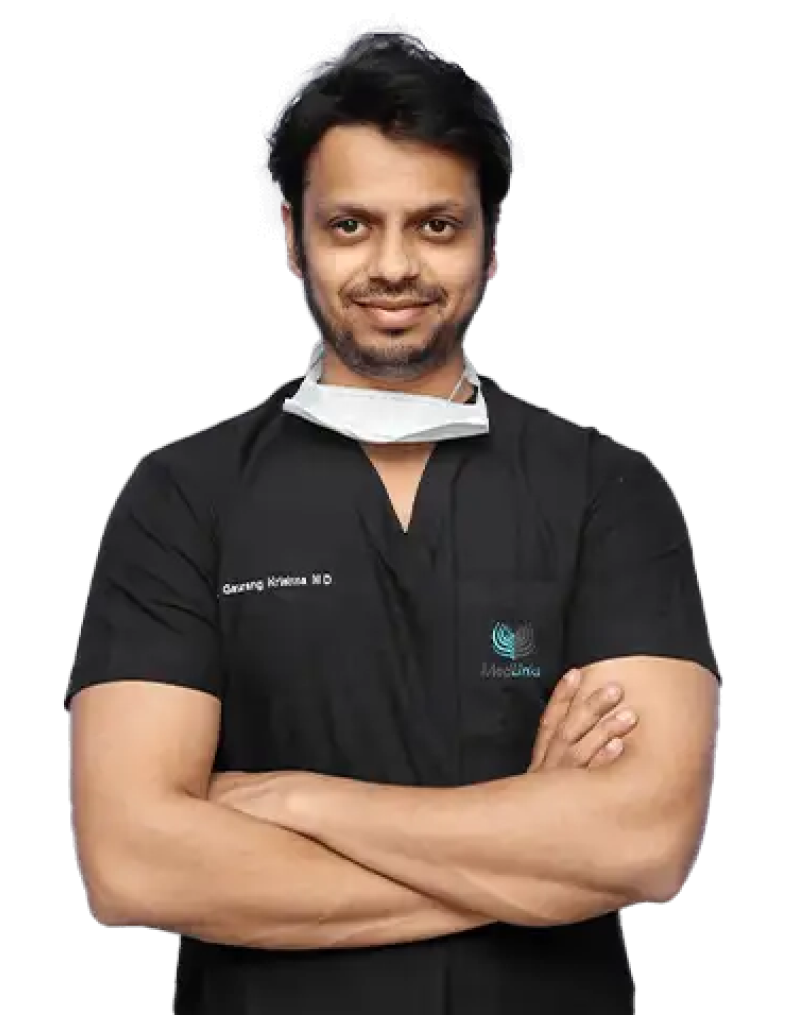Repair Hair Transplant
Surgery done by inexperienced and unqualified hands may turn out to be disastrous, giving a bad repute to the science and art of hair transplants.
Dr. Gaurang Krishna and many other suitable & genuine hair transplant clinics keep seeing such disasters. We can repair it and sometimes, the harm is beyond repair. Being an apex and one of the best hair transplant clinics in India, we keep seeing many patients who got unsatisfactory and unnatural hair transplant results. Hair transplant is a tricky surgery with numerous bottlenecks. The surgical outcome is not always good. The causes could be Patient related or surgeon related

Approach to correction
Correction Scenarios
Unnatural Hairline- Many times we get cases where the growth is good but the hairline is unnatural and detectable. In such cases, we use only scalp hair or body or nape of neck hair for singles and give a soft appearance to the hairline. Such cases are easily correctible.
Patchy growth- second scenario is when, by and large the results are OK but there are some patches of poor growth. In these cases, we try to use beard hair as shaving wont be needed. Beard hair grows very well and covers the gaps effectively
Re-do Cases
When overall very less growth is seen and more than 1000 grafts are needed, we call such cases as “Re-Do Procedures”.
Scenarios and Considerations
Heavy Extraction and poor growth– When the procedure is done by an enthusiastic but inexperienced team, we face the case of severely damaged donor area and scanty growth over the bald area. These cases are treated as someone with a poor donor and damaged recipient skin. Hence, we consider body and beard hair and try to improve the appearance as much as possible.
Focus should be on hairline as resources are less , so areas should be prioritized.
Keeping in mind the possibility of damaged recipient skin, we Don’t give high density.
These cases are most difficult to repair.
Less extraction less growth– We face such scenarios in surgeries done by commercial centres who fleece the patients by doing false promises like unlimited hair, full coverage, very cheap hair transplants. As the centres are money minded with zero morality and ethics, and the procedure mostly done by technicians, the patients are often tricked by a grossly less number of grafts. We treat such cases as a fresh procedure and do a full hair transplant (repair transplant) to fix the previously done bad hair transplants at our clinic.
Combined Repair
Combined repair is the overall procedure of removing large grafts and re-implanting the hair dissected from these grafts back onto the patient’s scalp, along with additional camouflage procedures which are performed by obtaining hair from a patient’s donor area. This is the most commonly performed hair transplant in delhi which provides patients with a natural looking hairline and better cosmetic results.
When is a Combined Repair recommended?
A combined repair is recommended in the following situations:
- Transplanted grafts are too large
- Grafts are located near the frontal hairline or the crown area
- Grafts have hair pointing in the wrong direction
At the practice of Dr. Gaurang Krishna, we customize the combined repair process for each patient depending on his/her situation and requirements. Our approach includes:
- Graft Excision
- Camouflage
- Suturing
Plug Removal
Our surgeons have rich experience in conducting the plug excision procedure wherein the hair graft of a patient is either fully removed from the recipient area or only a part of it is excised.
- Removing the unnatural looking, large grafts from the recipient area
- Suturing the holes created due to the removal of grafts
- Dissecting the plugs skillfully into individual follicular units
Re-implanting these follicular units back in the recipient area at the right angle and in a natural distribution
Dr. Gaurang Krishna and his team carefully close the holes after the removal of grafts, which helps in getting together the normal skin on either side of the excision and provides patients with the best cosmetic results, while minimizing the risk of scarring. For better results, we recommend patients undergo one or two sessions of FUT or FUE after the plug excision procedure.
Camouflage
Our team of experts perform the camouflaging process depending on the condition of each patient. If the grafts to be camouflaged are not too large, not discovered very close to the hairline, and have hair pointing in the right (forward) direction, we execute camouflage as a stand-alone technique.
On the other hand, if the grafts are to be excised, we first extract all the grafts that are a result of a bad hair transplant, redistribute the hair from those grafts, and perform camouflage as the final step. Our surgeons have rich experience in dealing with all kinds of grafts that cause cosmetic problems to patients such as the grafts made using the old plug technique, mini grafts, slit grafts, and punch-grafts, and perform a camouflaging procedure to provide patients with the best cosmetic results.
Fixing Scars
Any kind of scars including surgical scars (FUT or strip surgery Scars), eyebrow trauma scars, and burn scars can be treated using Hair Transplant. Experienced Hair Transplant surgeons such as Dr. Gaurang Krishna are experts in dealing with such cases. We have comprehensive experience in treating Burn and acid Injury cases. We do most of these cases Pro Bono (free of charge) as our social responsibility.

Frequently Asked Questions
Though the hair transplant’s longevity relies on aspects such as age, the severity of hair loss, hair kind, and lifestyle, the hair plugs can endure for a lifetime. This is because only the healthy hair follicles are transplanted into the balding sites to provide a natural, permanent, fuller hair look.
The term “Plug” or “Hair plug” refers to the conventional type of hair transplant performed from the 1950s until the early 21st century. The surgeon extracts hair follicles and places them in a plug-like fashion on the balding areas of the scalp. Hence the name “Hair plug.”
The hair plugs involve extracting larger sections of the scalp and placing them. The hair plugs can be painful, and the patient may experience pain during and after the procedure.
Whether someone is eligible for a hair scar repair will rely on several factors. For instance, if they have an inflammatory condition, it's suggested to wait at least 5 years of disease dormancy before getting this treatment. This is to ensure that diseases such as lichen planopilaris, psoriasis, and discoid lupus erythematosus are not active when the method is undergone.
Yes, it works! The transplanted hair is removed from the back of the scalp (donor site) and moved to the bald site (recipient site).
The transferred tissue is not “rejected” as it is not foreign tissue. The transplanted hair retains its characteristics; texture, colour, growth rate, and curl, after transplantation and re-growth.
Looking for guidance?
Book a consultation today and clear all your doubts with MedLinks!

Looking for guidance?
Book a consultation today and clear all your doubts with MedLinks!






























